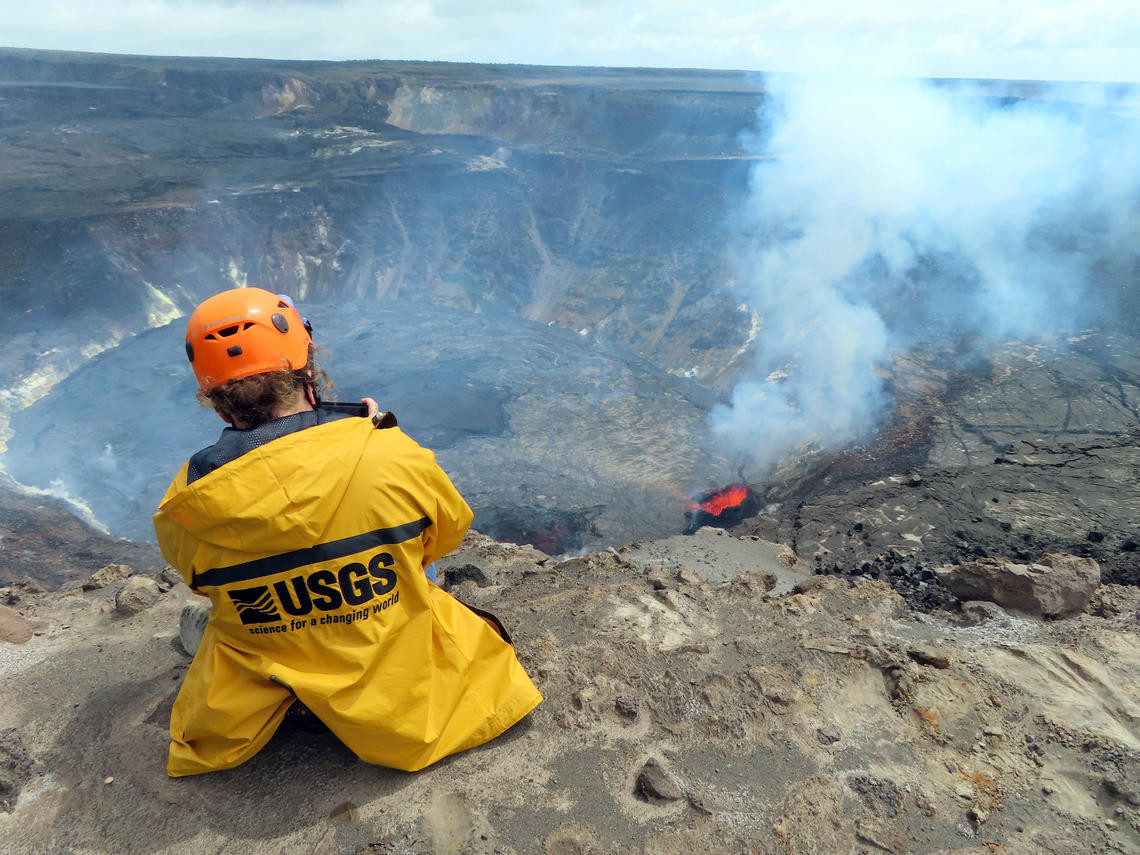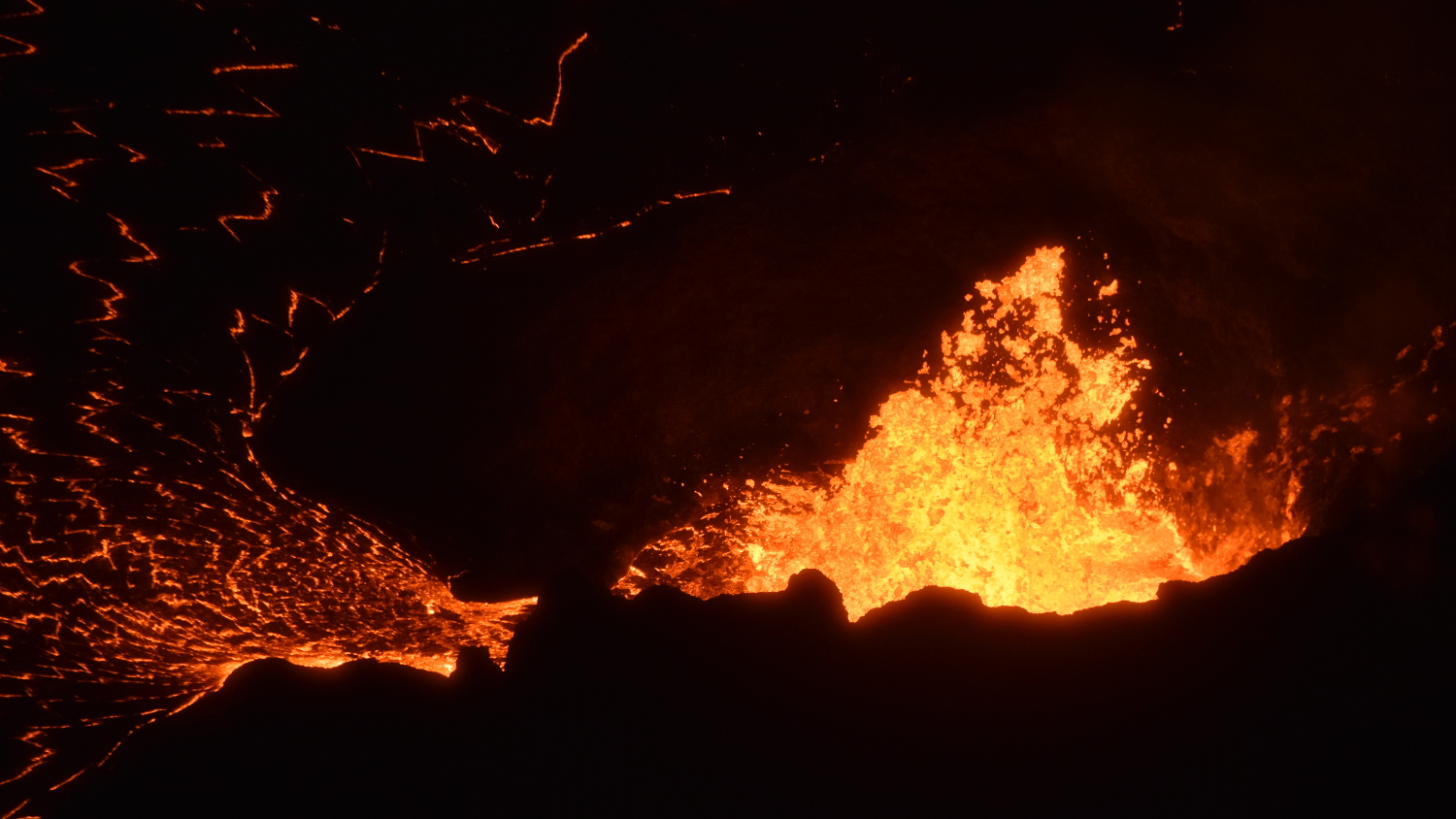
USGS: “USGS scientist takes video of the erupting west vent within Halema‘uma‘u crater, at the summit of Kīlauea. Photo taken from the northwest rim of Halema‘uma‘u at 12:27 p.m. HST on Oct. 8, 2021.” (USGS photo by J.M. Chang)
(BIVN) – The eruption of Kīlauea volcano continues, with lava confined to the summit caldera within Hawaiʻi Volcanoes National Park. There is little change in the overall activity, and seismicity and volcanic gas emission rates remain elevated.
The Volcano Alert Level remains at WATCH, with a Aviation Color Code of ORANGE. The USGS Hawaiian Volcano Observatory continues to closely monitor the activity.
On Wednesday morning, HVO issued this message:
Summit Observations: Sulfur dioxide (SO2) emission rates remain high, with a measured emission rate of approximately 6,800 tonnes per day on October 12, 2021, slightly higher than the past few days. Summit tilt was slightly deflationary yesterday, October 12, becoming flat overnight.
Halemaʻumaʻu Lava Lake Observations: Lava continues to erupt from a single vent in the western wall of Halemaʻumaʻu crater. The western end of the lake showed a maximum elevation of approximately 785 meters (2575 ft) above sea level when measured by field crews on October 12, which is a 2 meter (7 ft) increase over the past day and a total increase of about 42 meters (138 ft) since lava emerged on September 29. The total erupted volume since the beginning of the eruption was estimated to be about 15.9 million cubic meters (4.2 billion gallons) on October 8. The western vent had sustained fountain heights of 10-15 m (33-49 ft) to more variable heights – up to 30 meters (98 ft) – observed by field crews on October 12. The fountain has built a spatter cone with an approximately 10 meter (33 ft) wide opening facing east towards the lake. Lava is flowing into the lake through the spatter cone opening. The central island and several of the smaller eastern islets from the 2020 lava lake are still above the lake surface along with an island of the 2020 western vent rampart in the northwest part of the lake. The lava lake is not level across its surface due to the location of the vent in the western end. Areas closer to the vent are about 3-6 meters (10-20 ft) higher in elevation compared to the north and south part of the lake and 8 meters (26 ft) higher than the east end of the lava lake. Lava surface activity such as crustal foundering is seen on the western end of the lake and north and south of the central island but is no longer observed on the east end of the lake.
East Rift Zone Observations: No unusual activity has been noted in the Kīlauea East Rift Zone. Ground deformation motion suggests that the upper East Rift Zone – between the summit and Puʻuʻōʻō – has been steadily refilling with magma over the past year. SO2 and hydrogen sulfide (H2S) emissions from Puʻuʻōʻō were below instrumental detection levels when last measured on January 7, 2021.
Hazard Analysis: This new eruption at Kīlauea’s summit is occurring within a closed area of Hawai’i Volcanoes National Park. Therefore, high levels of volcanic gas are the primary hazard of concern, as this hazard can have far-reaching effects down-wind. Large amounts of volcanic gas—primarily water vapor (H2O), carbon dioxide (CO2), and sulfur dioxide (SO2)—are continuously released during eruptions of Kīlauea Volcano. As SO2 is released from the summit, it reacts in the atmosphere to create the visible haze known as vog (volcanic smog) that has been observed downwind of Kīlauea. Vog creates the potential for airborne health hazards to residents and visitors, damages agricultural crops and other plants, and affects livestock. For more information on gas hazards at the summit of Kīlauea, please see (this publication). Vog information can be found at vog.ivhhn.org.
Additional hazards include Pele’s hair and other lightweight volcanic glass fragments from the lava fountains that will fall downwind of the fissure vents and dust the ground within a few hundred meters (yards) of the vent (s). Strong winds may waft lighter particles to greater distances. Residents should minimize exposure to these volcanic particles, which can cause skin and eye irritation.
Other significant hazards also remain around Kīlauea caldera from Halemaʻumaʻu crater wall instability, ground cracking, and rockfalls that can be enhanced by earthquakes within the area closed to the public. This underscores the extremely hazardous nature of Kīlauea caldera rim surrounding Halemaʻumaʻu crater, an area that has been closed to the public since early 2008.
HVO says it will continue to issue daily Kīlauea Volcano updates until further notice.


by Big Island Video News9:31 am
on at
STORY SUMMARY
HAWAIʻI VOLCANOES NATIONAL PARK - Lava continues to erupt from a single vent in the western wall of Halemaʻumaʻu crater.